
current / archive / issues / faq / RSS feed / twitter /
Blog Archive: May 2019
Slayers From The Sea!We're back in the Marvel Universe again for this issue, which provides features a LOT of references to previous stories!
It all kicks off moments after the end of Giant-Size Super-Villain Team-Up #2 with Namor suddenly changing his mind and (quite sensibly) realising that Doctor Doom may not be the best person to ally yourself with. To begin with Doom argues his case, but then Namor points out some of the many times Doom has betrayed him recently, with footnotes linking back to stories in Giant-Size Super-Villain Team-Up #1, Fantastic Four #157 and Giant-Size Super-Villain Team-Up #2. As mentioned previously, Roy Thomas has cast doubt on the existence of these index cards, but from the amount of footnotes that keep cropping it there must surely have been some sort of indexing going on.
Namor flies off and initially Doom rails against him, calling him an "ungrateful water-snipe", but then stops and reflects, asking himself whether this problem has been caused by his own pride, in an (unfootnoted) reference to Fantastic Four #116.
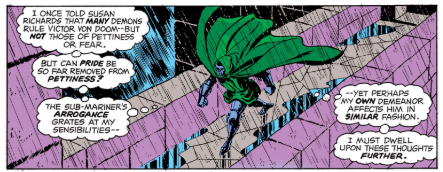 Doom retreats to his control room, where he looks at recordings of some of his many defeats. There's more evidence of research having gone here, as Doom looks back at stories told in "over a dozen" encounters with the Fantastic Four, as well as in
Thor #183, The Amazing Spider-Man #5, The Avengers #25 and The Incredible Hulk #144 (with a direct swipe from that issue's cover) and Daredevil #37.
Doom retreats to his control room, where he looks at recordings of some of his many defeats. There's more evidence of research having gone here, as Doom looks back at stories told in "over a dozen" encounters with the Fantastic Four, as well as in
Thor #183, The Amazing Spider-Man #5, The Avengers #25 and The Incredible Hulk #144 (with a direct swipe from that issue's cover) and Daredevil #37.
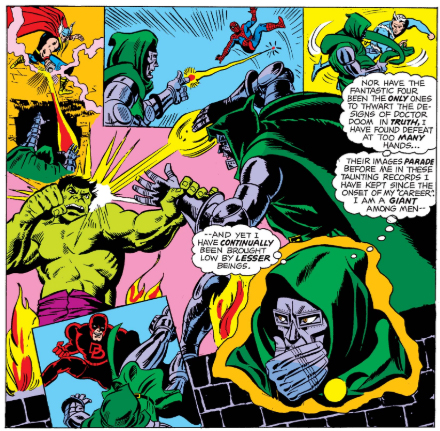 Having just spent a good ten minutes looking all of those up with my own set of index cards I certainly hope Tony Isabella had access to some when he was writing the story!
Having just spent a good ten minutes looking all of those up with my own set of index cards I certainly hope Tony Isabella had access to some when he was writing the story!
In a moment of surprising reflection Doom thinks to himself "I'd always thought I could stand against all mankind unaided, but the evidence of my eyes proves those vain thoughts false." This is a long way from the power-crazed megalomaniac who was only recently proclaiming himself as the rightful ruler of the world, and shows again how differently Doom appears when he's a lead character to when he's the villain of the month.
Doom thus decides that he will stand alone no more, and hatches a plan to follow Namor, so that when he's in trouble Doom can prove his worth by stepping in to help.
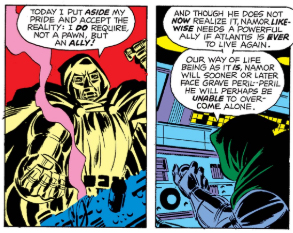 Doom here acts rather like a creepy/needy ex who believes that Namor just needs to wake up and realise how much they belong each other, and all will be well. He sends a robot fish to chase the Submariner, and thus ends part one of the story. The second part sees Namor returning to his current home of Hyrdrobase, where he is captured by a group of his own villains who, ironically, have decided to band together to fight him. This leads to a good old punch-up and an avalanche of footnotes before the issue ends with Namor defeated, at the mercy of his enemies.
Doom here acts rather like a creepy/needy ex who believes that Namor just needs to wake up and realise how much they belong each other, and all will be well. He sends a robot fish to chase the Submariner, and thus ends part one of the story. The second part sees Namor returning to his current home of Hyrdrobase, where he is captured by a group of his own villains who, ironically, have decided to band together to fight him. This leads to a good old punch-up and an avalanche of footnotes before the issue ends with Namor defeated, at the mercy of his enemies.
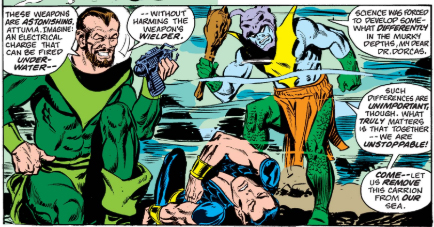 There's been no Doom at all in this second part of the story, which means we need to wait until the next issue to see if he comes charging in on (I assume) a white stallion to save Namor. Before that we're looking at a familiar story in an entirely different media, as the Doom arrives on the radio!
There's been no Doom at all in this second part of the story, which means we need to wait until the next issue to see if he comes charging in on (I assume) a white stallion to save Namor. Before that we're looking at a familiar story in an entirely different media, as the Doom arrives on the radio!
posted 31/5/2019 by MJ Hibbett
(click here for permanent link)
(0) comments
The Day Of Doom!
We've had various different versions of Doctor Doom before via the various cartoon series he's appeared in, but this issue of Spidey Super Stories marks the first time that an "alternate universe" version of Doom has appeared in an actual comic. Weirdly, it's a comic based on a TV show, which Doctor Doom did not even appear in!
"Spidey Super Stories" was a regular sketch feature on "The Electric Company", a TV show made by the Children's Television Workshop for children aged 6-10 i.e. the next age group up from kids who'd watched "Sesame Street". Spider-man would interact with a range of characters, often from other aspects of the show, in short comedy skits. Marvel didn't charge a licensing fee for this, most likely because they saw it as a way to draw children towards the comics, and this series was a tie-in designed to do just that, featuring adaptations of existing sketches plus new stories featuring other Marvel characters (none of whom ever appeared on the TV show).
The adaptations of existing sketches are pretty weird, as they stick with the actors and designs of the TV show, making some of it look a bit queasy.
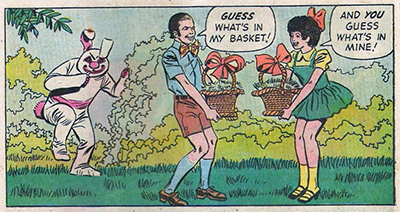 The art is gorgeous though, drawn by DC veteran Winslow Mortimer, and it's written by Jean Thomas, wife of Roy Thomas and author of "Night Nurse" around the same time. The stories are very straightforward but are not hugely different from regular Marvel comics, although they do have a distracting habit of splitting up sentences into seperate speech bubbles which makes it seem... like everybody talkes like ... William Shatner.
The art is gorgeous though, drawn by DC veteran Winslow Mortimer, and it's written by Jean Thomas, wife of Roy Thomas and author of "Night Nurse" around the same time. The stories are very straightforward but are not hugely different from regular Marvel comics, although they do have a distracting habit of splitting up sentences into seperate speech bubbles which makes it seem... like everybody talkes like ... William Shatner.
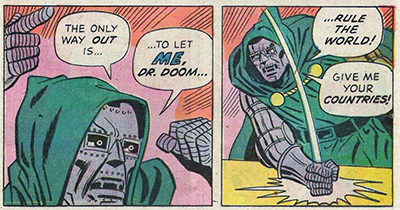 The story starts with a potted origin of Dr. Doom, and it's immediately obvious that he has been simplifed a LOT for a younger audience.
The story starts with a potted origin of Dr. Doom, and it's immediately obvious that he has been simplifed a LOT for a younger audience.
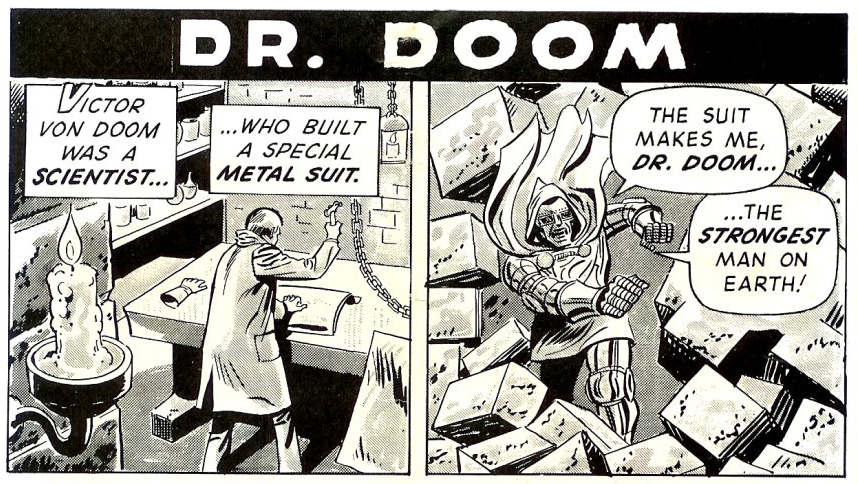 Interestingly he's still the King of a foreign country, and the image chosen to illustrate this does look rather similar to previous stories in 'Astonishing Tales', with his briefly glimpsed army reminiscent of Latverians seen in the same series.
Interestingly he's still the King of a foreign country, and the image chosen to illustrate this does look rather similar to previous stories in 'Astonishing Tales', with his briefly glimpsed army reminiscent of Latverians seen in the same series.
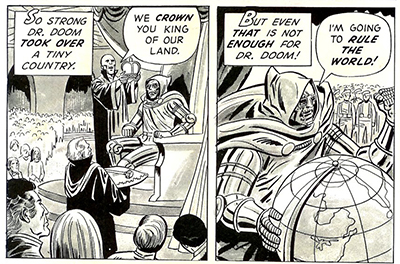 Doom himself is visually very much on-brand, drawn in exactly the same style as that set out by John Buscema a few years ago, although in this version he does seem to wear a wrist watch over his armour.
Doom himself is visually very much on-brand, drawn in exactly the same style as that set out by John Buscema a few years ago, although in this version he does seem to wear a wrist watch over his armour.
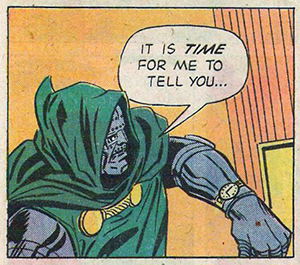 The storyline is very similar to the Hanna Barbera version of The Three Predictions Of Doctor Doom, with Doom trapping the United Nations inside a force field, and refusing to let anybody leave until they've all given him their countries. J Jonah Jameson and Robbie Robertson are also trapped inside, and there's a lovely running gag about Jonah thinking Doom was "peace loving".
The storyline is very similar to the Hanna Barbera version of The Three Predictions Of Doctor Doom, with Doom trapping the United Nations inside a force field, and refusing to let anybody leave until they've all given him their countries. J Jonah Jameson and Robbie Robertson are also trapped inside, and there's a lovely running gag about Jonah thinking Doom was "peace loving".
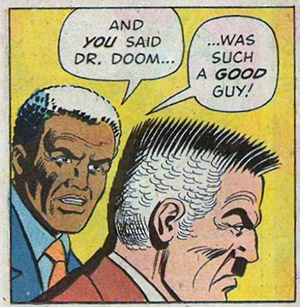 Spidey watches from outside the force field, and realises that it must be powered by electricity, so he writes a message using his webs to tell the team from The Electricity Company to pull the power. A character called "Easy Reader" (played by Morgan Freeman) uses the mighty power of literacy to read it, and the kids go off unplugging everything they can find.
Spidey watches from outside the force field, and realises that it must be powered by electricity, so he writes a message using his webs to tell the team from The Electricity Company to pull the power. A character called "Easy Reader" (played by Morgan Freeman) uses the mighty power of literacy to read it, and the kids go off unplugging everything they can find.
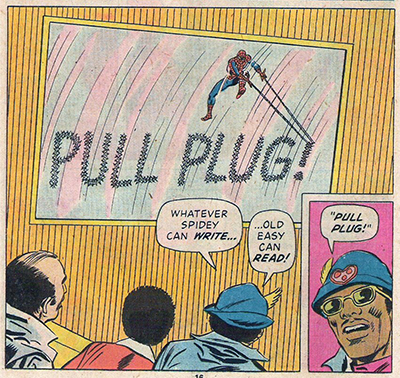 Duly defeated Doom tries to flee, only to be knocked out by Spidey, who's been able to get in now that the force field is down. It all ends with the police leading Doom away, and J Jonah Jameson still looking annoyed that he was wrong about Doom's character.
Duly defeated Doom tries to flee, only to be knocked out by Spidey, who's been able to get in now that the force field is down. It all ends with the police leading Doom away, and J Jonah Jameson still looking annoyed that he was wrong about Doom's character.
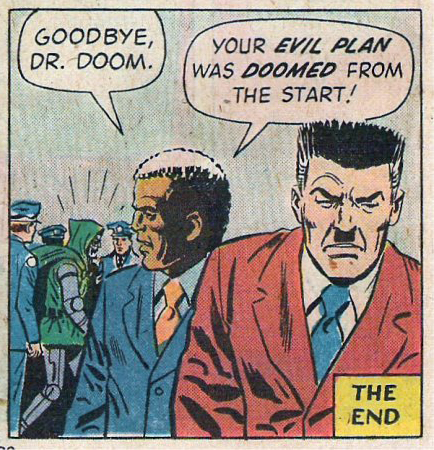 It's an elegantly done, really rather delightful story that, apart from aspects of the origin, is surprisingly close to Doom's usual characterisation!
It's an elegantly done, really rather delightful story that, apart from aspects of the origin, is surprisingly close to Doom's usual characterisation!
posted 24/5/2019 by MJ Hibbett
(click here for permanent link)
(0) comments
To Bestride The World!
After so much Doom in recent issues of The Fantastic Four it's something of a surprise when he doesn't appear for the whole first "chapter" (apart from the silent splash page) of the series he officially co-stars in. Instead we spend a lot of time with an oil tanker, especially two crew members called Mickey and Turk who are so distinctly drawn and written that I think they must be references to real people.
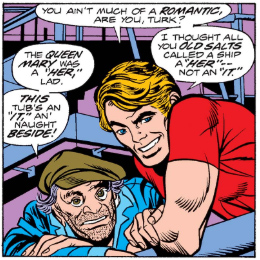 I guess they might be based on characters from a TV show but have no idea - any thoughts would be most welcome in the comments!
I guess they might be based on characters from a TV show but have no idea - any thoughts would be most welcome in the comments!
Namor shows up, tells them to leave Atlantean waters and then when they don't, sinks the ship. This does seem to be somewhat counter-productive - if he's bothered about surface dwellers impinging on his territory, surely he wouldn't want a dirty great tanker full of oil on the bottom of the sea - but he doesn't seem too bothered. Instead he heads back to Atlantis to mope around his people, who have been put in suspended animation, only being roused by the sounds of battle above.
This brings us to part two of the story, where he discovers an underwater army attacking the city. They're dressed in red and gold with a logo not unlike that of The Flash, but when Namor gets up close to one of them he discovers that it's -
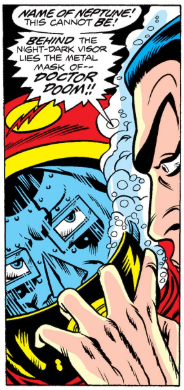 Except, of course, it isn't him - as usual Doom is not getting directly involved, he's simply projecting his face onto the inside of the helment, in a new twist on his old "floating TV screen" idea. He directs Namor to the surface, blowing up one of his own ships in the process to force him to get a move on, and when Namor arrives Doom greets him like an old pal.
Except, of course, it isn't him - as usual Doom is not getting directly involved, he's simply projecting his face onto the inside of the helment, in a new twist on his old "floating TV screen" idea. He directs Namor to the surface, blowing up one of his own ships in the process to force him to get a move on, and when Namor arrives Doom greets him like an old pal.
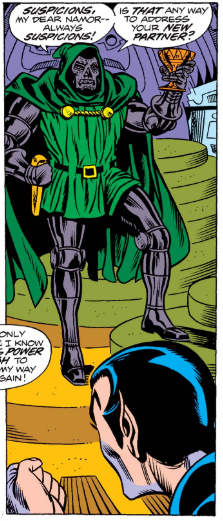 It turns out the attack was just a way to get Namor out in the open so Doom could re-propose an alliance. Personally, if I'm not answering my emails, I would prefer a phone call rather than a fleet of death robots attacking my flat, but super-villains probably have different priorities.
It turns out the attack was just a way to get Namor out in the open so Doom could re-propose an alliance. Personally, if I'm not answering my emails, I would prefer a phone call rather than a fleet of death robots attacking my flat, but super-villains probably have different priorities.
Doom tells Namor that he's reconsidered the matter and would like to have an alliance now, especially if Namor is going to be attacking the oil trade, as the more the world is in crisis the easier it is for Doom to seize control. There follows several pages of talking heads, dynamically illustrated nonetheless by Mike Sekowsky and Sam Grainger with cutaways and exciting expressions, where the pair discuss the nature of "super-villainy".
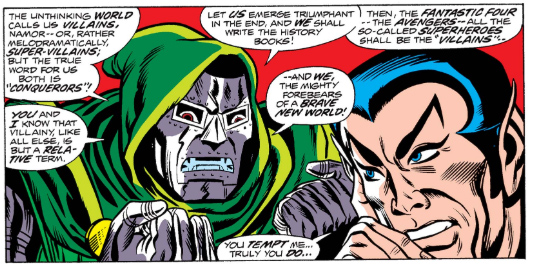 It's always weird in comics when the "villains" describe themselves as such, and Doom addresses this directly, saying that calling them "super-villains" is, to him, melodramatic and that, actually, seen from another angle it's them that are the heroes. As a brief SIDEBAR, I'd say that, according to screenwriting theory, characters like Doom and Namor really ARE the heroes. They're the ones who are always struggling against the system, striving to change themselves and the world, whereas the "superheroes" always act to maintain the status quo.
It's always weird in comics when the "villains" describe themselves as such, and Doom addresses this directly, saying that calling them "super-villains" is, to him, melodramatic and that, actually, seen from another angle it's them that are the heroes. As a brief SIDEBAR, I'd say that, according to screenwriting theory, characters like Doom and Namor really ARE the heroes. They're the ones who are always struggling against the system, striving to change themselves and the world, whereas the "superheroes" always act to maintain the status quo.
Anyway, their chat occurs as they fly back to Doom's castle in Latveria, where he unveils the latest version in a long line of android armies, which Doom is now using entirely instead of actual human lackeys because they are unable to betray him. Doom demonstrates this fact by ordering two nearby androids to fight to the death.
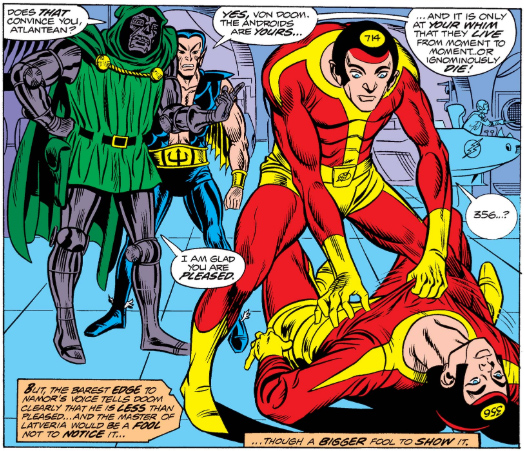 I love the simplicity of Android 714 whispering "356...?" here. It's a first gentle hint of problems ahead which Roy Thomas very skilfully builds up. The next hint follows soon after when they pass what appears to be a religious altar.
I love the simplicity of Android 714 whispering "356...?" here. It's a first gentle hint of problems ahead which Roy Thomas very skilfully builds up. The next hint follows soon after when they pass what appears to be a religious altar.
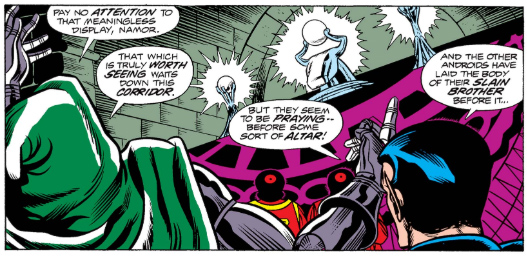 It never gets addressed in the story, but it's clear to anyone (who has read every single appearance of Doctor Doom so far) that the idols on the altar are meant to represent "The Faceless One" detaching his true form from his robot body way back in Astonishing Tales #3.
It never gets addressed in the story, but it's clear to anyone (who has read every single appearance of Doctor Doom so far) that the idols on the altar are meant to represent "The Faceless One" detaching his true form from his robot body way back in Astonishing Tales #3.
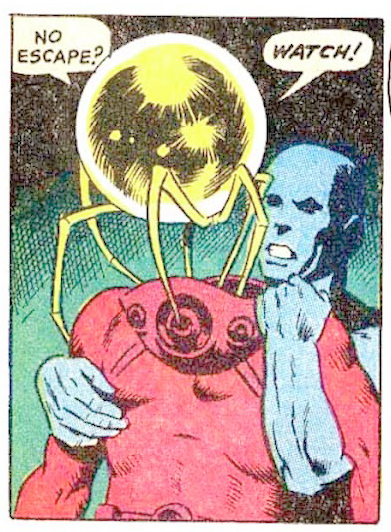 Hmm, didn't we talk about that particular issue recently?
Hmm, didn't we talk about that particular issue recently?
Doom dismisses this as a simple design flaw (which is odd, as surely his creations are perfect?) but Namor notices an odd look pass between two other androids. Again, this is lovely work from the whole creative team, slowly building up the sense that something isn't quite right and giving subtle hints as to what might be coming.
This is expanded on further over the next few pages as we see hundreds of androids worshipping at the altar, and the appearance of a Mysterious Figure who the androids bow down to. Doom and Namor are unaware, as they are viewing Doom's latest dastardly invention - solar panels!
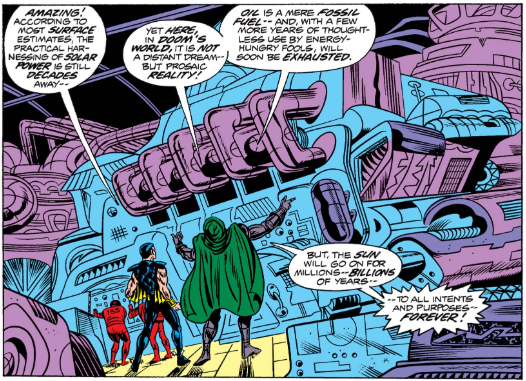 Doom, it turns out, is a green warrior, intent on replacing oil with solar power - what a madman!
Doom, it turns out, is a green warrior, intent on replacing oil with solar power - what a madman!
Doom brings his presentation to a close by showing how great their combined branding will be, drawing his own lighting flash logo (which has never previously been seen) over the top of Namor's trident.
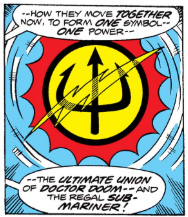 My advice: stick to Solar Energy, victor, brand design is not your strong point.
My advice: stick to Solar Energy, victor, brand design is not your strong point.
Before they can get onto a discussion about corporate fonts they are attacked by Doom's army of androids, now under the leadership of the Mysterious Figure, who is now calling himself "Andro, Lord Of The Androids".
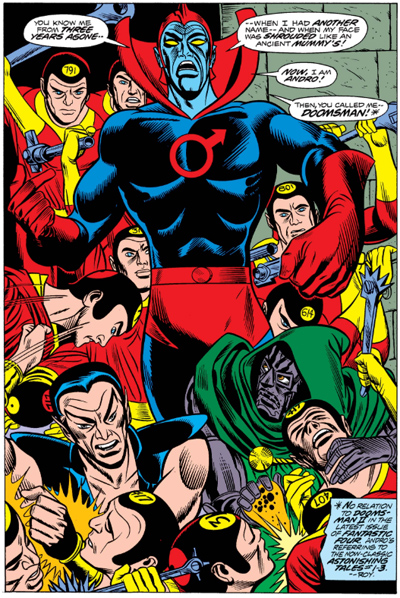 Andro is the original Doomsman - it's almost as if Roy Thomas went back and read Astonishing Tales as part of his recent data gathering exercise and came back with all sorts of ideas for new stories. Andro retells his origins, and explains how he escaped from the dimension where Doom exiled him. This involves yet more continuity, although this time it's to a story that hasn't even been published yet.
Andro is the original Doomsman - it's almost as if Roy Thomas went back and read Astonishing Tales as part of his recent data gathering exercise and came back with all sorts of ideas for new stories. Andro retells his origins, and explains how he escaped from the dimension where Doom exiled him. This involves yet more continuity, although this time it's to a story that hasn't even been published yet.
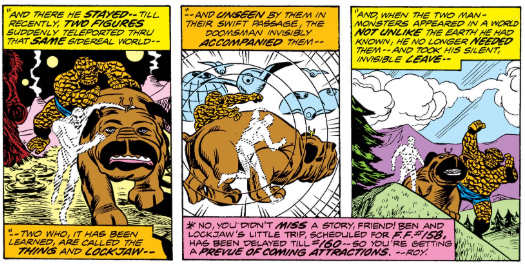 I've checked, and there's no mention of Doomsman in that issue, which seems an opportunity missed. A fight ensues, which Doom and Namor win by flooding the castle. These androids have been specifically designed to breath air (it's an anti-betrayal tactic, apparently), and Andro proves himself no better than Doom by sending his androids to drown. This is because, of course, Andro is designed to be a duplicate of Doom himself, with all of his ruthlessness. Andro points this out when the two of them come to blows, before immediately teleporting away.
I've checked, and there's no mention of Doomsman in that issue, which seems an opportunity missed. A fight ensues, which Doom and Namor win by flooding the castle. These androids have been specifically designed to breath air (it's an anti-betrayal tactic, apparently), and Andro proves himself no better than Doom by sending his androids to drown. This is because, of course, Andro is designed to be a duplicate of Doom himself, with all of his ruthlessness. Andro points this out when the two of them come to blows, before immediately teleporting away.
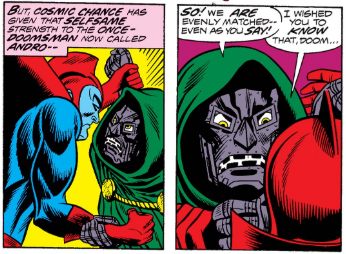 As with the previous story, a final battle is avoided through stalemate. This does seem to happen fairly often with Doom - I wonder if it's a way to avoid showing him actually winning? The triumph of evil was explicitly banned by The Comics Code Authority, and although they were much less powerful in 1975 than a decade or more earlier, especially after Amazing Spider-man #96 was issued without their approval (due to its mention of drugs), but perhaps Roy Thomas and other writers are still erring on the side of caution.
As with the previous story, a final battle is avoided through stalemate. This does seem to happen fairly often with Doom - I wonder if it's a way to avoid showing him actually winning? The triumph of evil was explicitly banned by The Comics Code Authority, and although they were much less powerful in 1975 than a decade or more earlier, especially after Amazing Spider-man #96 was issued without their approval (due to its mention of drugs), but perhaps Roy Thomas and other writers are still erring on the side of caution.
The story ends with another science fiction twist. Doom decides to go back to his original army of obedient robots, who never caused him any trouble, and as he and Namor go off to plot their next moves, we see a glint in the eye of one of his robot soldiers, suggesting matters might not be quite as straightforward as they think.
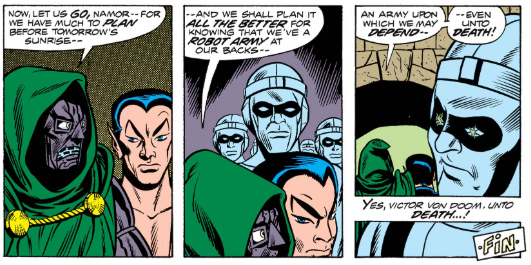 So ends the story and indeed the very short-lived "Giant-Sized" version of this series. Doom and Namor will return soon in a normal-sized version, but before then we have some distinctly different versions of Doom to enjoy, including what I think is the first alternate universe version of the character!
So ends the story and indeed the very short-lived "Giant-Sized" version of this series. Doom and Namor will return soon in a normal-sized version, but before then we have some distinctly different versions of Doom to enjoy, including what I think is the first alternate universe version of the character!
posted 17/5/2019 by MJ Hibbett
(click here for permanent link)
(0) comments
The MODOK Machine!
We're back to Minor Appearances again for this issue, as Doctor Doom appears in a single panel of a story which sees various supervillains being approached by a mysterious figure called The Black Lama, who wants them to compete for a "golden globe" which will bring them inner harmony and thus allow them to conquer the world. I would have thought that gaining inner harmony would mean you wouldn't be so bothered about conquering the world anymore, and Doctor Doom seems to agree, sending the lama packing.
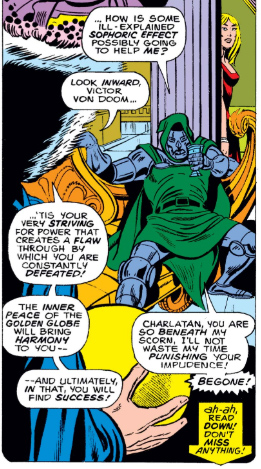 The Red Skull and Fu Manchu are similarly dismissive, leaving lesser villains like MODOK, The Mad Thinker and Titanium Man to punch it out. As ever, Doom is thus used as a signifier of Serious Supervillainy - his decision not to take part in the competition, alongside other heavyweights like the Red Skull, gives the reader clear guidance about exactly what sort of supervillain they're going to be seeing in this contest. Whiplash might turn up, but Galactus definitely won't!
The Red Skull and Fu Manchu are similarly dismissive, leaving lesser villains like MODOK, The Mad Thinker and Titanium Man to punch it out. As ever, Doom is thus used as a signifier of Serious Supervillainy - his decision not to take part in the competition, alongside other heavyweights like the Red Skull, gives the reader clear guidance about exactly what sort of supervillain they're going to be seeing in this contest. Whiplash might turn up, but Galactus definitely won't!
That's your lot for Doom in this story, but come back next time for more Giant-Sized Super-Villain Teaming-Up!
posted 15/5/2019 by MJ Hibbett
(click here for permanent link)
(0) comments
The Endgame Cometh!
This story kicks off right where the last one ended, with Ben Grimm complaining about Doctor Doom's use of technology, as "every time I put the kibosh on 'im he turns out to be a blasted robot!" It's a fair complaint, which Doom himself witnesses via his usual video screen.
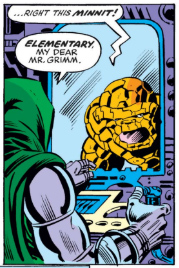 Doctor Doom sure does love his video screens! He then tears himself away from the telly to witness the birth of his latest humanoid creation, which he's decided to call "Doomsman II", after the creature we last saw back in Astonishing Tales #3. Unusually Roy Thomas doesn't give us a reference for this one, although he does then have Doom refer to his attempted alliance with Namor in Giant-Size Super-Villain Team-Up #1.
Doctor Doom sure does love his video screens! He then tears himself away from the telly to witness the birth of his latest humanoid creation, which he's decided to call "Doomsman II", after the creature we last saw back in Astonishing Tales #3. Unusually Roy Thomas doesn't give us a reference for this one, although he does then have Doom refer to his attempted alliance with Namor in Giant-Size Super-Villain Team-Up #1.
We then cut to The Silver Surfer and Shalla Bal, who have a go at that tried and tested amnesia cure "snogging" to see if it'll help Shalla Bal remember who she is.
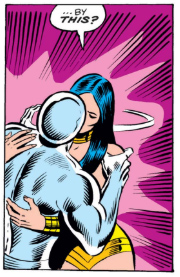 Before we can find out if it worked we swicth to the Fantastic Four making their way through the castle although, yet again, it's The Fantastic Three, with Medusa just tagging along. They turn a corner and find themselves face to face with Doomsman II in the second chapter of the story, which is called ...
Before we can find out if it worked we swicth to the Fantastic Four making their way through the castle although, yet again, it's The Fantastic Three, with Medusa just tagging along. They turn a corner and find themselves face to face with Doomsman II in the second chapter of the story, which is called ...
 To save you the bother, it means "a situation in which the obligation to make a move in one's turn is a serious, often decisive, disadvantage." I'm not entirely sure that it appplies here, but it does have a lot of "Z"s in it.
To save you the bother, it means "a situation in which the obligation to make a move in one's turn is a serious, often decisive, disadvantage." I'm not entirely sure that it appplies here, but it does have a lot of "Z"s in it.
After a bit of fighting we return to find that yes, smooching IS a medically proved memory aid, as Shalla Bal realises that she's not Shalla Bal at all, but a local Latverian girl called Helena who happens to look exactly like her, and in whom Doom implanted vague memories in order to use her against the Silver Surfer. The swine!
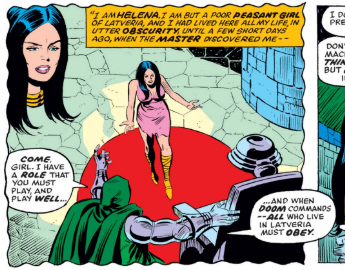 Almighty HECK then kicks off, with the Surfer joining the FF to defeat the Doomsman but, just as they are about to fully put the kibosh on Doom, Helena intervenes to point out that they are equally matched, and that any further battle will "destroy this castle and all the archives in it - the priceless treasure trove of a nation's legacy!" It's an interesting argument against fighting Doom - and one which many people have, and in future will, entirely ignore - and in this case it works, with all sides realising they have reached another chess (mixed with tennis) analogy.
Almighty HECK then kicks off, with the Surfer joining the FF to defeat the Doomsman but, just as they are about to fully put the kibosh on Doom, Helena intervenes to point out that they are equally matched, and that any further battle will "destroy this castle and all the archives in it - the priceless treasure trove of a nation's legacy!" It's an interesting argument against fighting Doom - and one which many people have, and in future will, entirely ignore - and in this case it works, with all sides realising they have reached another chess (mixed with tennis) analogy.
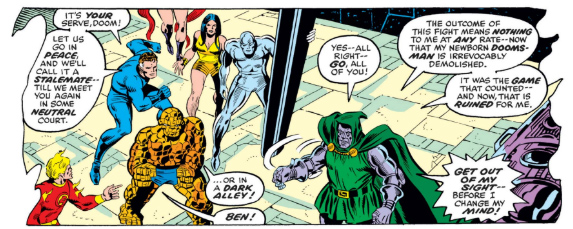 Yes, it IS a stalemate, not zugzwang at all! But what's this? Just as Doom fumes about the fact that he lost control of proceedings the frame borders tatter and we pull back to see that - oh no! - the whole thing was a cunning ploy by Mephisto to punish The Silver Surfer. That really WAS Shalla Bal all along, unbeknownst to herself, Doctor Doom or anybody. I'm not quite sure how this is an attack on the Surfer, as he had no idea either, but still Mephisto seems quite pleased with himself.
Yes, it IS a stalemate, not zugzwang at all! But what's this? Just as Doom fumes about the fact that he lost control of proceedings the frame borders tatter and we pull back to see that - oh no! - the whole thing was a cunning ploy by Mephisto to punish The Silver Surfer. That really WAS Shalla Bal all along, unbeknownst to herself, Doctor Doom or anybody. I'm not quite sure how this is an attack on the Surfer, as he had no idea either, but still Mephisto seems quite pleased with himself.
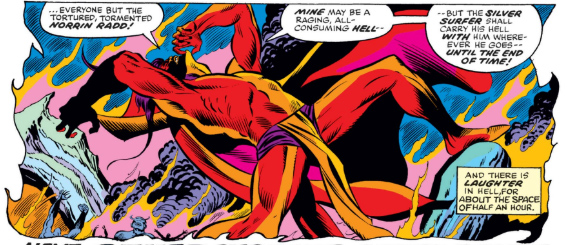 It's an odd, unsettling ending to a storyline which has never quite seemed to know where it's going, or what it's using the characters for. This will be Doctor Doom's last appearance in "Fantastic Four" for a couple of years, but he's going to be busier than ever, with his own (shared) series to look at and, next time, even more Minor Appearances!
It's an odd, unsettling ending to a storyline which has never quite seemed to know where it's going, or what it's using the characters for. This will be Doctor Doom's last appearance in "Fantastic Four" for a couple of years, but he's going to be busier than ever, with his own (shared) series to look at and, next time, even more Minor Appearances!
posted 10/5/2019 by MJ Hibbett
(click here for permanent link)
(0) comments
Middle Game!
The title for this issue isn't shown on the front cover, possibly because it's so dull. "Middle Game"? I know it's a reference to chess (which sort of appears in the story) and the fact that this is part two of a three part story, but come on Roy Thomas, even going with "Doom's Day" for the 219th time would have been better!
Doom exhibits several of his usual signifiers in this issue, notably his preference for keeping out of the main action by sending in robots to do his work and/or watching things on a TV screen. There's also some of the above mentioned chess, although it's not chess as you and I might know it. Here Roy Thomas and Rich Buckler hark back to Jim Steranko's Strange Tales #167 where Doom played a game of "chess" with The Prime Mover, moving figurines of the main players across a board to (somehow) express their actions in real-life.
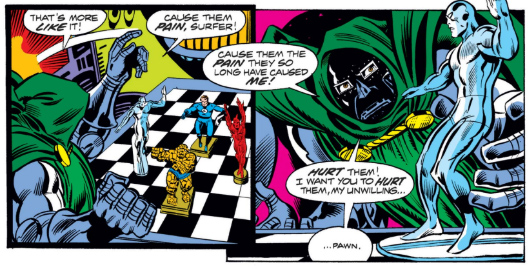 It was never clear how that worked before, and it's not explained here - indeed, Doom himself suddenly realises that the Silver Surfer figure he holds in his hand is a "pawn", "as all men are but pawns in the hands of Victor Von Doom," hinting that maybe it's not meant to be Actual Chess at all. This is followed by yet another use of Roy Thomas's index cards, with a link to Fantastic Four #57-60) - since writing the previous blog I've read an interview with Roy Thomas where he claims to have no memory of these cards, and to find them unlikely. Reading through this batch of comics with their sudden increase in references and footnotes, it does look to me as if some sort of record keeping system had recently come into play, so perhaps Roy just forgot about them?
It was never clear how that worked before, and it's not explained here - indeed, Doom himself suddenly realises that the Silver Surfer figure he holds in his hand is a "pawn", "as all men are but pawns in the hands of Victor Von Doom," hinting that maybe it's not meant to be Actual Chess at all. This is followed by yet another use of Roy Thomas's index cards, with a link to Fantastic Four #57-60) - since writing the previous blog I've read an interview with Roy Thomas where he claims to have no memory of these cards, and to find them unlikely. Reading through this batch of comics with their sudden increase in references and footnotes, it does look to me as if some sort of record keeping system had recently come into play, so perhaps Roy just forgot about them?
Doom returns to watching his viewscreen, where he's horrified to see that the Silver Surfer has decided not to kill the FF after all. This leads to a recap of both the previous issue of this story AND the events in Giant-Size Super-Villain Team-Up #1, which ends with Doom spotting the Surfer coming back with the Fantastic Four captured.
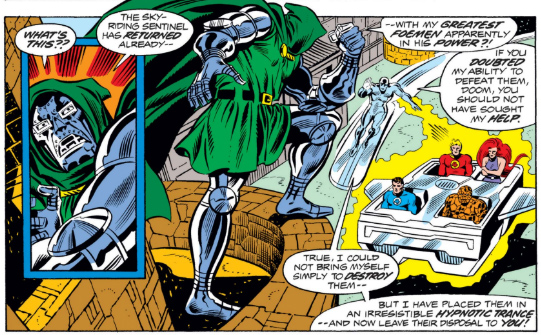 Up until this point Doctor Doom has behaved very much in anti-hero mode, as a schemer who doubts his own actions rather than a power mad dictator, but next he gives the Surfer a lecture where he paraphrases George Orwell's description of the future as "a boot stamping on a human face — forever", twisting it to refer to a desired outcome for his own quest for power.
Up until this point Doctor Doom has behaved very much in anti-hero mode, as a schemer who doubts his own actions rather than a power mad dictator, but next he gives the Surfer a lecture where he paraphrases George Orwell's description of the future as "a boot stamping on a human face — forever", twisting it to refer to a desired outcome for his own quest for power.
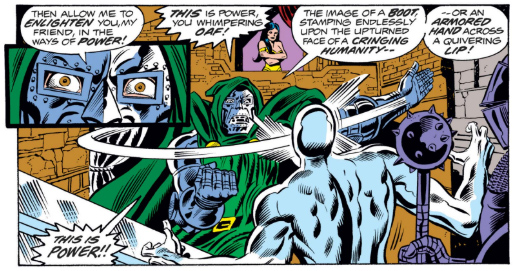 The Surfer totally loses his temper, ripping apart a suit of armour which Doom then uses his own powers to rebuild. This apparently demonstrates that they're equally matched so don't need to have a proper fight, which is a bit of a shame if you ask me. Instead of having a punch-up Doom shows the Surfer where he is keeping the Fantastic Four, with each of them trapped in a prison specifically designed for their own powers. This makes the Surfer wonder what on earth can have happened to Doom to make him behave this way, and Doom reveals that it is, basically, envy.
The Surfer totally loses his temper, ripping apart a suit of armour which Doom then uses his own powers to rebuild. This apparently demonstrates that they're equally matched so don't need to have a proper fight, which is a bit of a shame if you ask me. Instead of having a punch-up Doom shows the Surfer where he is keeping the Fantastic Four, with each of them trapped in a prison specifically designed for their own powers. This makes the Surfer wonder what on earth can have happened to Doom to make him behave this way, and Doom reveals that it is, basically, envy.
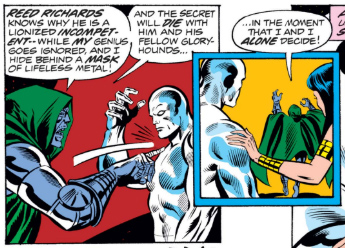 This is another lurch back to Doom being a damaged, almost relatable figure, away once more from the power-crazed dictator. He and The Silver Surfer have very much been the stars of the comic so far - we're over halfway through the issue and the Fantastic Four themselves haven't really done anything - and that feeling continues as Doom instructs a lackey called "Daedalus" to take the Surfer to a chair in another room. Doom, once again watching from a view screen, finds this hilarious for reasons which will become clear later.
This is another lurch back to Doom being a damaged, almost relatable figure, away once more from the power-crazed dictator. He and The Silver Surfer have very much been the stars of the comic so far - we're over halfway through the issue and the Fantastic Four themselves haven't really done anything - and that feeling continues as Doom instructs a lackey called "Daedalus" to take the Surfer to a chair in another room. Doom, once again watching from a view screen, finds this hilarious for reasons which will become clear later.
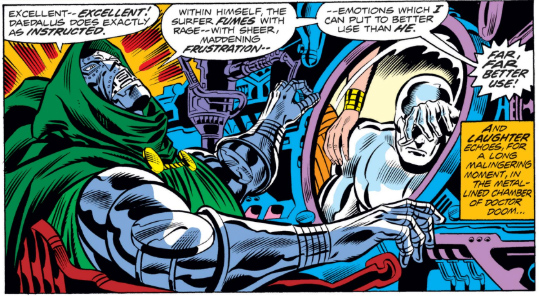 At this point we finally focus on The Fantastic Four who, as before, behave much more like The Fantastic Three with Medusa being mostly ignored. They quickly notice the flaw in Doom's prison - that if they work together they can free each other seperately - and The Fantastic Three free each other while Medusa... just takes off the helmet holding her hair in. They advance through an army of Doom's "death dealing humanoids" (with Medusa completely disappearing from most of the action - why did they bother including her in the team if they weren't going to use her?) before finally reaching Doom himself who turns out to be ... a robot.
At this point we finally focus on The Fantastic Four who, as before, behave much more like The Fantastic Three with Medusa being mostly ignored. They quickly notice the flaw in Doom's prison - that if they work together they can free each other seperately - and The Fantastic Three free each other while Medusa... just takes off the helmet holding her hair in. They advance through an army of Doom's "death dealing humanoids" (with Medusa completely disappearing from most of the action - why did they bother including her in the team if they weren't going to use her?) before finally reaching Doom himself who turns out to be ... a robot.
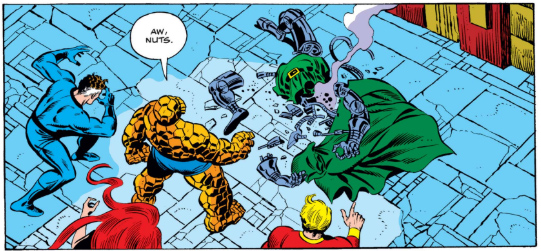 Well exactly - it must be getting repetitive for them by now. The story ends with Doom laughing away to himself as he watches the Surfer sitting in his special chair which, it turns out, is being used to drain his power in order to charge up yet another of Doom's creatures. We'll find out more about it in the next story which is called, in the ongoing chess narrative, "Checkmate!"
Well exactly - it must be getting repetitive for them by now. The story ends with Doom laughing away to himself as he watches the Surfer sitting in his special chair which, it turns out, is being used to drain his power in order to charge up yet another of Doom's creatures. We'll find out more about it in the next story which is called, in the ongoing chess narrative, "Checkmate!"
posted 3/5/2019 by MJ Hibbett
(click here for permanent link)
(0) comments